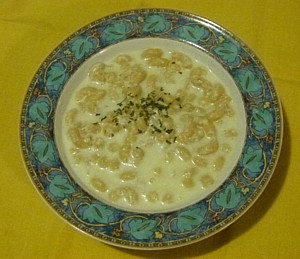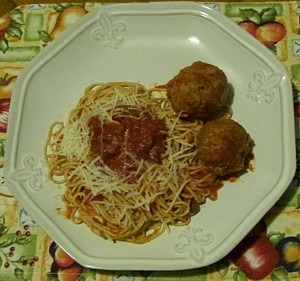

Macaroni, Spaghetti, and Vermicelli
When I told a friend about a recipe for macaroni and cheese found in a Philadelphia cookbook dated 1844 she inquired about its shape. I didn’t know. That started a search to find out when macaroni and cheese get adopted by New Englanders and its shape. The title of this page comes from Mrs. Lincoln’s 1884 Boston Cooking School Cook Book.
“These are thick pastes made from wheaten flour mixed with a small quantity of water. They are made to take various shapes by being forced through holes in metallic plates. These plates are arranged over a fire; and the macaroni, as it issues from the holes, is partially baked, and afterward hung to dry over rods. Vermicelli is used in soup and puddings; macaroni and spaghetti as vegetables.”
The term shapes is not clear. Lincoln states, “Macaroni, as frequently prepared, in long pieces” “Macaroni – Break one quarter of a pound of macaroni in three-inch pieces,” “Spaghetti – This is a variety of macaroni about one eighth of an inch in diameter. It is usually served unbroken.” These descriptions show the wheaten paste, what we call pasta, came out in long strands in three different diameters. The same distinction is still used today: Angel Hair, Vermicelli, Spaghetti, etc. are all long strands of varying diameters. However these are variations on the spaghetti aspect not the macaroni aspect. Today macaroni is known by its actual shapes: elbows, shells, etc.
One of the first things for cook books was to decide what category should macaroni be listed under. Some cook books placed it under “Vegetables” wheat being a plant. One cook book listed it under “Cereals” wheat being a grain product. It was not exactly easy to classify.
The earliest cook book in New England with a recipe for macaroni that included cheese is the 1855 Improved Housewife. It had two Canadian recipes: Montreal Macaroni Pie – a one crust pie filled with cooked macaroni, grated cheese and milk, and baked with an open top. The second was Quebec Macaroni Pudding – a two crust pie filled with cooked macaroni and milk, covered with a top crust and baked.
The 1884 Boston Cooking School Cook Book had several recipes:
a) Macaroni – Cooked macaroni cut into one inch pieces, with a white sauce
and bread crumb topping, baked.
Optional: grated cheese half being mixed with the macaroni and half
mixed with the crumb topping.
b) Macaroni and Tomatoes – Cooked macaroni cut into one pieces with a
tomato sauce, thickened with flour like a white sauce, and no spices.
c) Spaghetti – “It is usually served unbroken.” That is in long strands. Serve
the same as macaroni, with cream or tomato sauce, cheese, and crumbs.”
“serve without cutting, if you are skilled in the art of winding it around
your fork, as the Italians do.”
A distinction was made between spaghetti which was served in long strands and macaroni which was served in short pieces.
In the 1896 Boston Cooking School Cook Book there are greater distinctions in the recipes. For years some cook books called for baking the macaroni, cheese and milk. Other cook books called mixing the ingredients and serving it. This cook book listed Boiled Macaroni served with cream and re-heated on top of the stove. Baked Macaroni and Baked Macaroni with Cheese was cooked macaroni mixed with white sauce with or without cheese, crumbs on top and baked until brown. As of this edition, Spaghetti is now “usually served with tomato sauce.”
In the past hundred years not much has changed with the exception of the shape of macaroni. Kraft’s Mac n’ Cheese, an instant version, still uses cheese (powdered) mixed with milk, and stirred in with miniature macaroni. Our ancestors called this “Boiled Macaroni”. “Baked Macaroni and Cheese” recipes are in our modern cook books.
Macaroni and Cheese, and Spaghetti are All American favorites. New England like other areas in America adopted the recipes from Britain who had adopted them from Italy. This is a quote from the Cook’s Oracle 1836 Edinburgh edition. “The usual mode of dressing it [macaroni] in this country is by adding a white sauce, and Parmesan or Cheshire cheese, and burning it; Or boil Macaroni as directed in the receipt for the Pudding, and serve it quite hot in a deep tureen, and let each guest add grated Parmesan and cold butter, or oiled butter served hot, and it is excellent; this is the most common Italian mode of dressing it.” (page 354) The paring up of macaroni and cheese comes to us from Italy.
Macaroni and Cheese or Mac n’ Cheese
Homemade version of instant type formerly called “Boiled”
Most recipes call for grated cheese to be sprinkled on the macaroni and a small quantity of sauce poured over the dish. I find it makes the dish too dry. Another recipe said if you want a “creamy version” use cheese sauce. I chose a recipe with double the quantity of white sauce and added cheese to make a creamy cheese sauce. It can be served with or without baking in the oven. This recipe serves 2 – 3 people.
No Bake Method
Cook ¼ pound (approximately 1 cup) dry macaroni in boiling salted water for 10 to 15 minutes
(to your desired softness)
In a sauce pan make 2 cups Thin White Sauce
Combine
2 Tablespoons butter, melted
2 Tablespoons (level) flour
Add
2 cups milk
¼ teaspoon salt
Stir frequently while heating
Heat until it comes to a low boil.
Place White Sauce in double boiler pan or keep in sauce pan with heat on low
Add
1 cup grated cheddar cheese
Heat until cheese is melted
Pour over boiled macaroni and serve
Baked Method
Follow directions for “No Bake Method”
Place macaroni with cheese sauce in a greased casserole baking dish,
Cover with:
½ cup Buttered Cracker or Bread Crumbs
Bake in 400 degree oven until browned, approximately 15 minutes, serve
Spaghetti, Tomato Sauce or Spaghetti Sauce, and Meatballs
Meatballs
Most meatball recipes call for rolling the raw ground meat into small balls and frying them until brown. I find this prevents the flavor of the sauce from penetrating the meatballs. My mother’s recipe from the 1950’s had cracker crumbs and eggs mixed in with the ground meat which helped hold it together. The type of cracker affects the taste of meatballs. Ritz and other distinctly flavored crackers impart their own taste. I prefer saltines which do not alter the taste of the ground beef. She always placed the meatballs (raw) directly into the sauce. This makes the meatball softer and tastier.
½ pound ground beef (Hamburg)
½ medium onion, chopped fine
1 egg, (small)
10 saltine crackers, crushed fine
Dash of pepper
1 tablespoon parsley, chopped (fresh or dried)
Mix thoroughly and form into 1½ inch diameter balls, carefully drop into hot spaghetti sauce Cook 1 hour on a simmer (low boil)
Recipe can easily be doubled
Spaghetti Sauce / Tomato Sauce
Spaghetti sauce is flavored with Italian spices. Tomato sauce is not flavored. This is an individual choice.
In a sauce pan:
3 tablespoons olive oil
1 onion, chopped
1 clove of garlic, minced
½ green pepper, chopped, optional
1 can (6 oz.) tomato paste
1 large can tomatoes (about 2½ cups)
Oregano (to taste)
Basil (to taste)
Heat to boiling, turn heat down to simmer. Add raw meatballs. Cook on a simmer for 1 hour.
Add water as needed if it becomes too thick. Sauce should be thick. Flavor is better the next day.
Spaghetti, Thin Spaghetti, Vermicelli, or Angel Hair
In a large pot bring salted water to a boil (½ teaspoon salt)
Place ½ pound spaghetti in the boiling salted water, stir frequently, cook 10 to 15 minutes to desired softness
Drain spaghetti in a colander
Remove meatballs from sauce
Add spaghetti to hot sauce
Serve spaghetti with meatballs and grated hard cheese (Parmesan or Romano)


